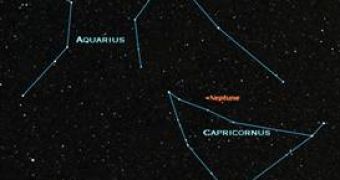This week, you will be able to see two of the gas giants in the night sky. With the moon out of the way, and a pair of binoculars, Uranus and Neptune will be well in your reach. Normally, most people can see the five brightest planets, but there is still a sixth planet that can't be observed without any optical help. Both planets are well placed on the night sky, and this is the best moment to view them.
Neptune and Uranus are the two last planets, and the most far away in the solar system. Previously, the solar system was considered to house nine planets, but because Pluton is so small it was taken away from its rank as a planet.
Uranus is the seventh planet in the solar system and the third in size. It has a diameter slightly higher than Neptune, but it's thought to have a lower mass. It is known as a gas giant with a mass at least 14.000 times that of the Earth. The atmosphere is mainly composed of hydrogen, fifteen percent helium and two percent methane. It orbits the Sun from a distance of 1.8 million miles, and has a diameter of about 32.000 miles.
Uranus is thought to have a rocky core, on top of which there is a mantle formed of several liquid elements and substances. It has 27 moons that orbits the planet around its equator in which there are a series of nearly opaque rings. The weather is extremely wild since it has an axis of spin tilted to about 97 degrees, meaning that when the Sun rises on the north pole it will shine for 42 years.
You can see it on the night sky between the stars of Aquarius, using a pair of binoculars or a telescope as a tiny pale-green featureless disk.
Neptune, the last planet in the solar system and most dimmer, seven times dimmer than Uranus, was discovered during long observations of Uranus's orbit. As scientists watched the orbit of Uranus, the saw certain perturbations that suggested that there must be another planet that is affecting its orbit.
It is situated at a distance of 2.8 billion miles away from the Sun, and has 13 moons. To be able to find Neptune in the sky, you would need a pair of good binoculars and a dark sky, but to observe it at least 200-power magnification telescope is needed. Voyager 2 passed by both planets, in its path leading away from the Sun, and photographed Neptune in 1989 showing a deep-blue atmosphere, with extremely fast winds and a cloud formation similar to Jupiter's Great Red Spot, and the existence of faint rings formed of very fine particles.

 14 DAY TRIAL //
14 DAY TRIAL //